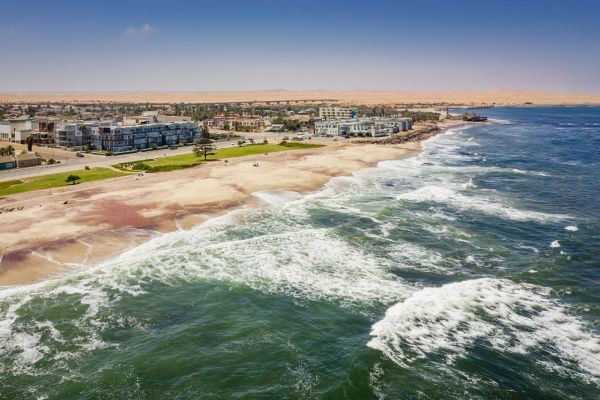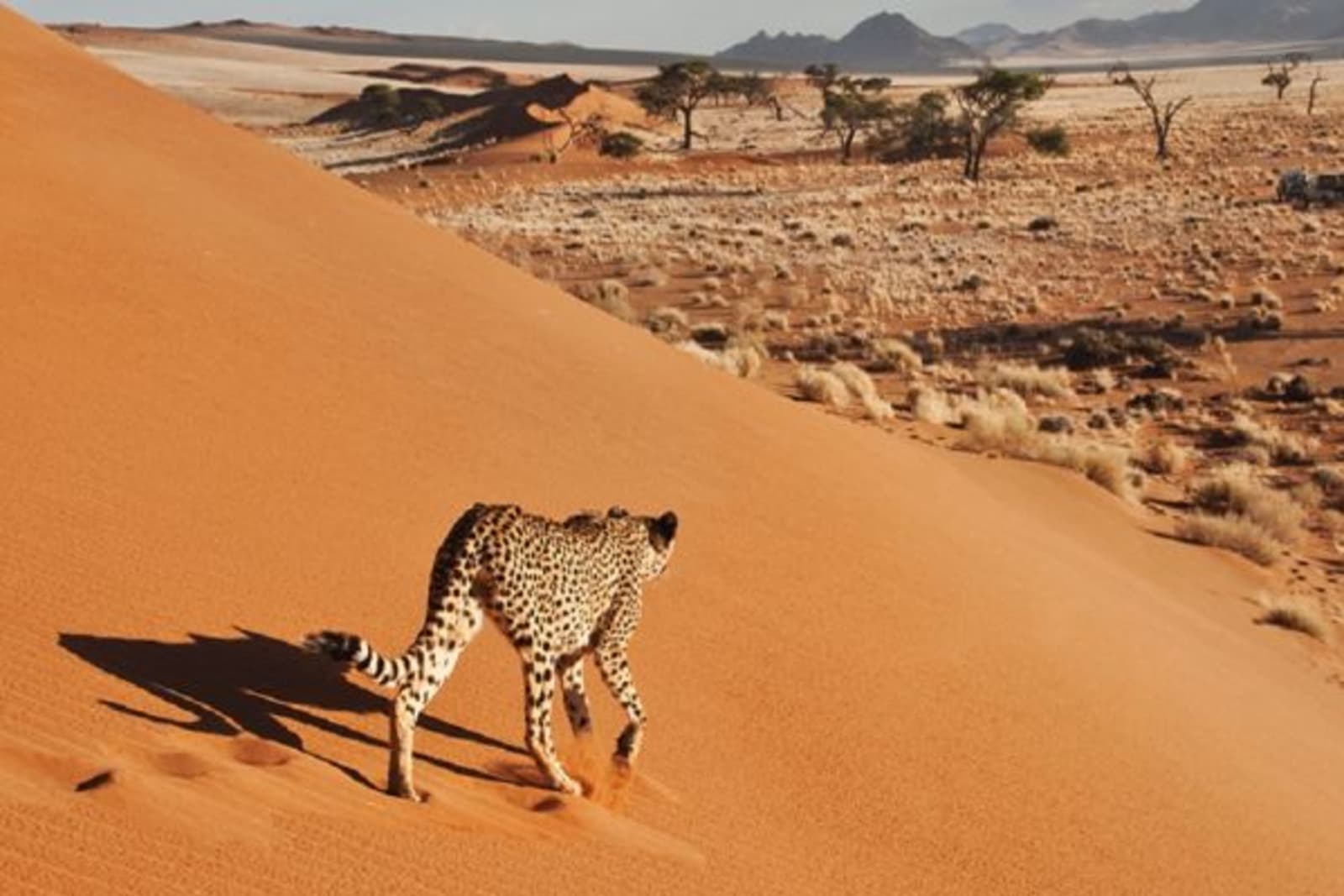NamibiaTravel Guide
Grab your stout-soled footwear and wide-angle lens, Namibia is a wonderland for adventurers and dreamers. Characterised by its vast desert areas, rusty-red dunes and dramatic coastline, this enigmatic destination is unique in Southern Africa, and pretty much the world. In fact, arriving here feels an awful lot like you’ve walked off the Earth or stepped onto another planet – Mars perhaps? If one thing is certain, venturing through Namibia is not about sipping cocktails on the beach and resort life. The ruggedly beautiful country has an abundance of wildlife and German heritage, while its unusual scenery offers outdoorsy travellers a massive playground across which to 4x4, hike, and bike. From conquering the dunes on foot or sandboarding down them to sipping sundowners on the edge of the Fish River Canyon, you find that things to do in Namibia always have a unique and exciting twist.
Namibia quick facts
Language
National language
English
Beverages
Bottle of Coke/Pepsi (330ml)
GBP £0.72
Local time
Monday
12:38pm
Currency
Namibian dollar
GBP £1.00 = NAD $22.25
Eating out
Restaurant meal (casual dining)
GBP £7.41
Electricity
Plug type: D
3 pins • 220V
Explore Namibia
Where to stay in Namibia?
Namibia offers a bounty of accommodation options in vastly different settings, from along the Skeleton Coast (named after the many shipwrecks in centuries past) to the modern capital city of Windhoek or the wilds of the Caprivi Strip. It really all depends on where you feel most at home.
Namibia’s laid-back capital city is just the place for safari-goers to clean off the dust and stock up on travel essentials. If you’re wanting a boutique hotel with a stellar view, check yourself into the centrally located Hotel Thule. Looking to splurge? The ultra-luxurious Olive Exclusive should get you oohing and aahing.
If you’re venturing into Namibia’s famous Etosha, known for its abundant wildlife, there are plenty of lodges and camps to try. Onguma Bush Camp remains a strong favourite, with its open-air lapa and game-rich waterhole. Parents take note: this camp is also child-friendly, should you want to bring the little ones along for the ride.
Sandwiched between the desert and the ocean, Namibia’s adventure capital of Swakop offers a wide range of accommodation choices. Want to level up on luxury? Snap up a stay at the Strand Hotel. On a shoestring? Keep it low-key at Skeleton Beach Backpackers.
While Namibia’s iconic Skeleton Coast can be somewhat tough to reach, it’s not impossible. Hiring a 4x4 or taking a tour are good bets. And if you’ve got room in the budget, then there’s only one place to stay, and that’s Shipwreck Lodge. If you’re feeling the pinch but still desperate to experience ‘The land God made in anger’, bed down at Terrace Bay.
Believe us when we say, this is just the start. Book your Namibia accommodation today!
Things to do in Namibia
As most of our travel experts will tell you, you’ll find no shortage of things to do in Namibia. To give you an idea, here are a few of our favourite handpicked experiences worthy of your itinerary:
Climbing, or shall we say scrambling, up Dune 45 (85km high) has become a rite of passage for travellers making their way through Namibia. This sandy ‘mountain’ is not only easy to access, but you’ll also get a stellar vantage point overlooking the Namib Desert. Wondering about the name? It stems from its location at the 45th kilometre of the road connecting the Sesriem gate and Sossusvlei (landmark salt and clay pan). Add it to your list if you don’t mind a bit of sand in your shoes!
While the Fish River Canyon may only be the second-largest canyon in the world it certainly gives the Grand Canyon a run for its money. The best time to go? Either sunrise or sunset, when the light amplifies the finer details of eroded rock and craggy crevices. Don’t forget to keep your camera fully charged and your Windhoek Lagers ice-cold.
There are no two ways about it. A visit to the Deadvlei is a must for first-time travellers to Namibia. Characterised by its skeletal camel-thorn trees, this iconic landmark is located inside the Namib-Naukluft Park near the Sossusvlei and is guaranteed to have shutterbugs salivating. GoPros and cameras at the ready!
Low light pollution and dark, clear night skies make Namibia an excellent place for stargazing anytime of the year. One of the best locales to explore its star-spangled sky is the Gamsberg, Namibia’s largest table-shaped mountain. It provides the highest elevation of the Great Escarpment so you’ll really feel a part of the Milky Way.
We’re not sure why, but the Caprivi Strip is one of the most overlooked regions in Namibia to explore. This lush stretch of land boasts a healthy bounty of flora and fauna, along with plenty of crashing waterfalls and rapids – yes, please! Bordering Botswana, Zambia and Angola, it’s also referred to as the ‘Caprivi finger’, due to its long, narrow shape. Worth exploring for sure.
Nambia is not all desert and dunes. Quietly nestled in the northern reaches of the country, Etosha National Park is teeming with wildlife. It’s just the place to go if you’re wanting that quintessential safari experience during your travels. Keep a keen eye out for gemsbok (oryx), giraffe, and elephants on patrol. Chances are you’ll also tick a few skulking predators off the list.
Along with the ochre-daubed Himba people, Namibia is also associated with the San people whose culture is regarded as one of the oldest in the world. Many of their ancient drawings remain etched across the Erongo Mountain range, with the oldest sample of rock art in Southern Africa painted in a cave called Apollo 11 in the Huns Mountains in southern Namibia.
Looking for an immersive experience? Then a Namibia tour is the way to go.
Namibia food and drink
Joe’s Beerhouse in Windhoek has become something of an institution for tourists and locals alike. If you’re up for a hearty meal, a cold beer and a good dose of fun, this is the spot to go. The decor is eclectic, the beer is always cold and the menu offers a solid mix of German- and Namibian-inspired cuisine. Joe’s is also the perfect place to get your game meat fix or tuck into traditional pork knuckle (Schweinshaxe). However, if you’re in the mood for something fancier, book your table for two at Leo’s at the Castle. This upmarket restaurant serves a fine blend of international, French and African cuisine on the terrace. Overall, the capital city offers a little bit of everything. Even if you’re just passing through, grab yourself a pastry at one of those Deutsch bakeries – there’s one tucked around every corner! Over in Swakopmund, the Tug Restaurant takes first prize for quirkiness. Moored up to the pier and overlooking the Atlantic Ocean, diners can taste their way through fresh West Coast lobster, prawns, mussels and calamari. Don’t forget to wear your stretchy pants! Most lodges and camps outside main towns in Namibia offer a wide variety of food suited to all palates. However, if you have any dietary requirements, it’s always best to check before you travel.
Get a real taste for the local cuisine by booking a Namibia tour.
Where to shop in Namibia?
While you're definitely visiting Namibia for more than a spot of shopping, here's where to go to pick up a souvenir or two.
Of course, no one visits Namibia to explore a shopping mall, but if you need to stock up on a range of items, The Grove Mall in Windhoek ticks all the right boxes. Interestingly, this retail mecca stands as the first regional mall and the largest in the country. However, those seeking one-of-a-kind trinkets and handmade souvenirs will definitely want to give it a miss.
Located in Windhoek, this local initiative provides a platform for nearly 40 sellers from rural communities to earn a living. From jewellery to carved tree roots, and even delicious cheesecake, you’re bound to stumble across something special. You’re also guaranteed a degree of authenticity as only goods made in Africa are sold here.
Located in the tiny town of Okahandja, this local market showcases the sheer diversity of wooden crafts in Namibia. Mosey your way through and you’ll encounter traders chiselling anything from massive giraffes and elephants to masks and tiny ornaments fashioned from macalani seeds. The traders here may seem a little too eager for you to visit their shop, but overall, it’s part of the experience and quite commonplace at most African markets.
When is the best time to travel to Namibia?
Given that the country enjoys more than 300 days of sunshine per year, the best time to travel to Namibia is year-round. The mean annual temperature for Namibia is 20.6°C, with average monthly temperatures ranging between 16°C and24°C. However, each season has its own quirks and perks, so timing your arrival really just depends on what you want to do and see.
Namibia’s highest rainfall is from December to March, but generally consists of sudden storms which blow over pretty quickly. This is the best time to travel to Namibia if you love your birdwatching, but best skip the coastal towns if you’re not keen on braving the crowds.
If it’s wildlife you’re after, then June to October is the best time to travel to Namibia. During these hot winter months, rain is sparse and the bush thins out, prompting animals to congregate around the waterholes. Although it remains warm during the day, mornings and evenings can be chilly.
April and May are known as Namibia’s off-peak ‘shoulder season’ when it’s not too hot, or too cold. Etosha is lush and green during this time, and some desert dunes will even showcase a smattering of wild flowers.
The temperature and humidity steadily rise throughout the months of November and December in the build-up to the first rains. Although the weather is highly unpredictable during this time, hearing those electric storms crackle across the desert is incredibly special.
Don't miss out. Book your Great Britain flight today!
How to get around Namibia
One thing Namibia is known for is its extensive road network making car hire and self-drive really attractive not to mention affordable.
If you love a good road trip, Namibia is the destination for you. Embarking on a self-drive adventure really is the best method of getting around, as long as you have a reliable vehicle. The roads are well signposted between the main sights, and well maintained, allowing you to efficiently move from A to B.
One of the most adventurous and economical ways of getting around in Namibia is by overland safari. With this option, all of your transport, accommodation and most meals are included, allowing you to simply kick back and get the most out of your time, hassle-free. If you don’t mind roughing it a bit, this one’s for you.
If you’re short on time, you might want to consider a fly-in safari via charter plane. Although this option will stretch your budget, you’ll certainly reduce your travel time, while enjoying a bird’s eye view of the most soul-stirring scenery of the Skeleton Coast.
With a total of 29 Airports in Namibia, it’s safe to say that it’s pretty well-connected. Hosea Kutako International Airport stands as the country’s flagship airport located 45 minutes’ drive from the capital of Windhoek. Swakopmund Airport serves the city of Swakopmund.
Let us help you organise your own wheels for exploring. Hire a car in Namibia today!






